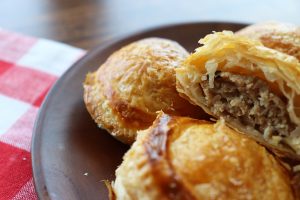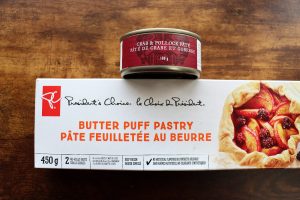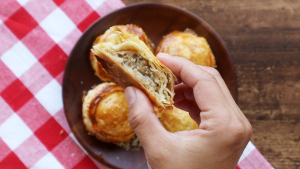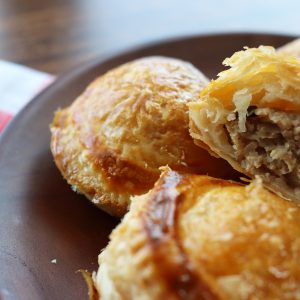Vietnamese Pâté Chaud (Bánh Patê Sô)

It’s hard to find a child who grew up in Vietnam who doesn’t love Pâté Chaud (Bánh Patê Sô). Who could resist the mouthwatering aroma, the crispy, flaky crust, and the savoury filling of meat and pâté? Like many, I once assumed that Pâté Chaud was purely a French creation. However, it turns out that the Vietnamese deserve much of the credit for this delightful pastry.
So, what exactly is the origin of Vietnamese Pâté Chaud?
Vietnamese Pâté Chaud, known locally as “bánh patê sô,” is a savoury pastry with deep French and Vietnamese roots. The dish’s origins can be traced back to the colonial period in Vietnam, when the French introduced various aspects of their culture, including their cuisine. One of these culinary imports was the French “pâté chaud,” a hot meat pie made with puff pastry and filled with seasoned pork or other meats.
During the period of French rule (1858-1954), Vietnamese cooks began incorporating French techniques into their own food traditions, merging local ingredients with Western methods. Pâté chaud is one such example, a marriage between the buttery, flaky puff pastry of France and the use of pork, pâté, and fish sauce typical of Vietnamese cuisine.
Over time, bánh patê sô became a popular snack, often sold in bakeries and eaten as a light meal or street food. It is enjoyed hot, straight from the oven, with its crispy layers and savoury filling being a favourite for many. Though similar to its French counterpart, the Vietnamese version often has a more robust, umami-rich filling due to the inclusion of local ingredients like fish sauce, oyster sauce, and mushrooms.
Today, bánh patê sô remains a symbol of Vietnam’s colonial past while standing on its own as a beloved part of the country’s culinary landscape. It can be found in bakeries across Vietnam and Vietnamese communities worldwide, offering a delicious blend of two cultures in every bite.

Here are a few notes on my Pâté Chaud recipe:
- Overall, making Vietnamese Pâté Chaud is quite easy, although preparing the dough for the crust can be a bit time-consuming. To speed up the process, I use President’s Choice Butter Puff Pastry, which comes with two pre-rolled sheets. Each sheet yields 5-6 Pâté Chaud (3-inch diameter). You can likely find a similar product at your local supermarket.
- Traditionally, the filling for Vietnamese Pâté Chaud includes liver pâté. Since I haven’t found a good liver pâté, I use crab and pollock pâté for this recipe instead. Feel free to use any pâté you like – as long as your pâté chaud turns out delicious, that’s all that matters!
Q&As on Vietnamese Pâté Chaud
1. Can I substitute ground pork with another type of meat in my pâté chaud?
Yes, you can substitute ground pork with other types of meat, such as ground chicken, turkey, or beef, depending on your preference. Keep in mind that the flavour and texture may differ slightly depending on the meat you choose. Ground chicken or turkey will provide a lighter taste, while beef may add a richer, more robust flavour. Just ensure that the meat you select is well-seasoned to complement the pâté and other ingredients in the filling.
2. Can I make vegetarian Pâté Chaud?
Absolutely! You can make a vegetarian version of Pâté Chaud by substituting the meat and pâté with plant-based alternatives, such as sautéed mushrooms, tofu, or a vegetarian pâté. Be sure to adjust the seasonings to complement your chosen ingredients. I’ll be creating a vegetarian Pâté Chaud recipe soon, so stay tuned for more detailed instructions!
3. I don’t want to use store-bought puff pastry sheets. Can I create the crust for my Pâté Chaud from scratch?
Yes, you can definitely make the crust from scratch! The ingredients typically include all-purpose flour, butter, lime juice, water, and a pinch of salt. However, this method is more time-consuming, as it involves creating the flaky layers by repeatedly folding and rolling the dough. I’ll be sharing a detailed recipe for homemade puff pastry soon, which you’ll be able to find under Essentials > Batter & Breading. Stay tuned for that!

4. Why does this pastry have a French name, even though it’s a Vietnamese creation?
Although the pastry has a French name, the full name is almost always referred to as “Vietnamese Pâté Chaud,” affirming its Vietnamese identity. The dish emerged during the French colonial period, when many French culinary techniques and ingredients were introduced to Vietnam. The Vietnamese adopted these influences and transformed them into something unique, including this savoury pastry. The French name remains as a nod to its origins, but the recipe itself has been adapted and embraced as a beloved Vietnamese creation.
5. Can I find Vietnamese Pâté Chaud in any bakery?
Vietnamese Pâté Chaud is commonly found in many Vietnamese bakeries, particularly in areas with large Vietnamese communities. However, it may not be available in every bakery, especially outside of those communities. Your best bet is to visit a Vietnamese bakery or an Asian supermarket that offers baked goods. You can also try making them at home with a simple recipe for an authentic taste!

Recipe for Vietnamese Pâté Chaud (Bánh Patê Sô)
Equipment
- 1 small nonstick skillet
- 1 oven
Ingredients
For the Filling:
- 200 grams ground pork
- 100 grams pâté
- 1 medium onion
- 5 shiitake mushrooms
- 5 mL sesame oil
- 15 mL fish sauce
- 15 mL oyster sauce
- A pinch of garlic powder
- A pinch of MSG (or chicken bouillon powder)
- A pinch of ground black pepper
For the Crust:
- 450 grams butter puff pastry
- 1 egg
Instructions
- Prepare the Filling:Finely dice the shiitake mushrooms and onion.Heat a small skillet over medium heat, add a drizzle of oil, and sauté the diced onion and mushrooms for a few minutes until softened and fragrant. Season with a pinch of salt, if desired.In a large mixing bowl, combine the ground pork, pâté, sautéed onion, and mushrooms.Add the sesame oil, fish sauce, oyster sauce, garlic powder, MSG (or chicken bouillon powder) and black pepper to the pork mixture. Adjust the seasoning if needed.Mix thoroughly until the ingredients are well combined and the seasonings are evenly incorporated. Allow the filling to marinate for at least 30 minutes, giving the flavours time to meld and intensify.
- Prepare the Pastry:In separate small bowls, lightly beat the egg white and egg yolk. These will be used to seal the pastry and create a golden finish during baking.Roll out the puff pastry. Use a round dough cutter to cut out equal numbers of top and bottom pastry pieces for each pâté chaud. The size of the cutter will determine how many pastries you can make.
- Assemble the Pâté Chaud:Place a generous spoonful of the prepared filling in the centre of each bottom pastry piece, being careful not to overfill, as this could cause the pastry to burst during baking.Lightly brush the edges of the bottom pastry with a bit of beaten egg white, which will help the top layer adhere and seal properly.Gently place the top pastry piece over the filling, aligning it with the bottom piece. Press the edges together firmly to seal the pastry, ensuring the filling is securely enclosed.To give the pâté chaud a more refined shape, press the opening of a small glass gently into the centre of each pastry. This will help define the form and enhance its presentation.Generously brush the tops of each assembled pâté chaud with the beaten egg yolk to give them a golden, glossy finish as they bake.
- Bake the Pâté Chaud:Carefully arrange the assembled pâté chaud on a baking sheet.Preheat your oven to 170°C (340°F), allowing it to reach the correct temperature before baking the pastries.Bake the pâté chaud for 20-25 minutes, or until the pastry is beautifully puffed and turns a deep golden brown. The filling should be cooked through, and the exterior should be crispy and flaky.
- Serve:Serve the pâté chaud hot, straight from the oven, while the crust is still crisp and the filling is warm and savoury. Enjoy them as a delicious snack or light meal!

